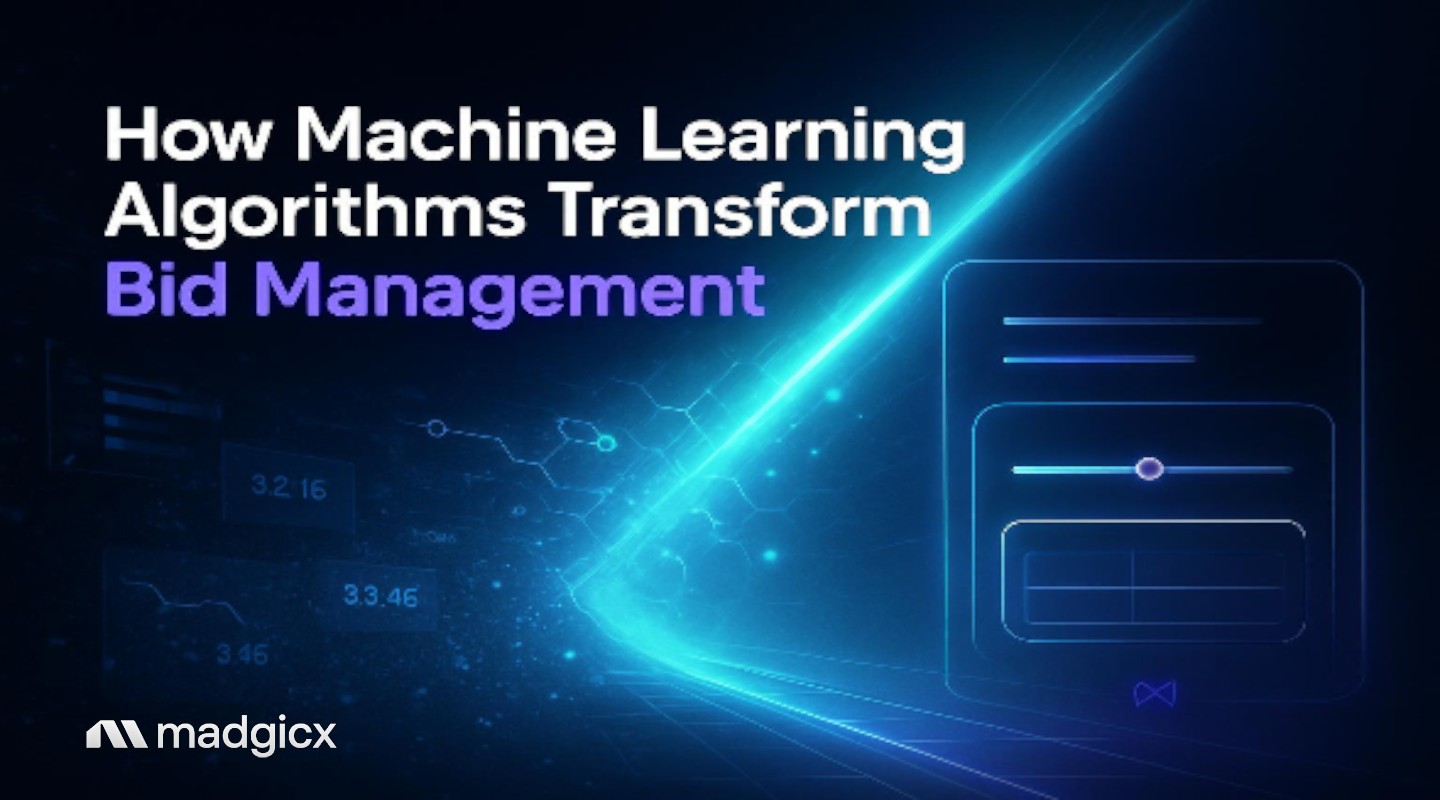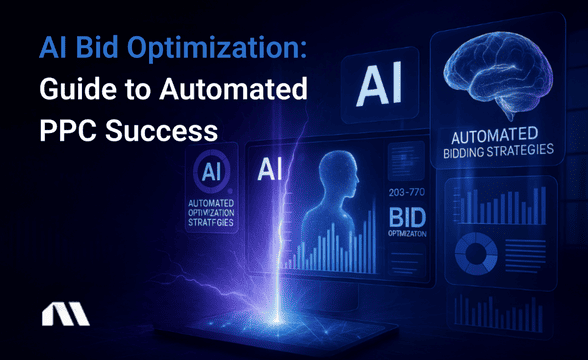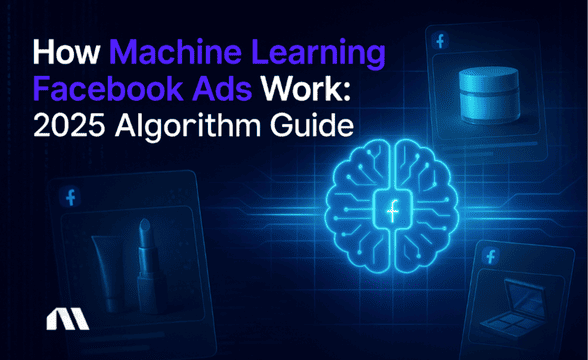Learn how machine learning algorithms for bid management optimize advertising bids in real-time. Full guide with proven strategies and ROI frameworks.
Picture this: You're staring at your Facebook Ads Manager at 2 AM, manually adjusting bids for the third time today. Your cost per acquisition just spiked 40%, and you're not sure if it's a temporary blip or the start of a performance nosedive. Sound familiar?
Here's the thing – while you're burning the midnight oil making educated guesses, many advertisers are using machine learning algorithms for bid management to automate these optimization tasks. Machine learning algorithms for bid management use artificial intelligence to optimize advertising bids in real-time based on conversion likelihood, user signals, and campaign performance data to maximize ROI while achieving target cost goals.
The shift is already happening. According to Google's Smart Bidding documentation, 80% of advertisers now use some form of automated bidding – and those who don't are missing optimization opportunities.
We're about to show you exactly how to implement these proven strategies with a complete implementation framework that combines ML theory with practical optimization strategies.
What You'll Learn
- How ML algorithms predict optimal bid amounts using real-time data signals
- 5 proven bidding strategies with specific implementation frameworks
- Advanced ROI measurement techniques for attribution and performance tracking
- Bonus: Madgicx-specific optimization workflows that significantly reduce manual optimization time
Understanding Machine Learning Algorithms for Bid Management
Let's start with a reality check. Remember when you used to manually adjust thermostat settings throughout the day? Now your smart thermostat learns your patterns and adjusts automatically.
That's essentially what's happening with machine learning algorithms for bid management – except instead of room temperature, we're optimizing for conversions and ROI.
Machine learning algorithms for bid management represent the process of using artificial intelligence to analyze hundreds of real-time signals. These include user behavior, device type, time of day, location, browsing history, and conversion probability to determine the optimal bid amount for each auction.
Unlike rule-based automation that follows "if this, then that" logic, ML algorithms continuously learn and adapt based on new data.
Here's what makes machine learning algorithms for bid management fundamentally different from manual management:
- Real-Time Signal Analysis: While you might consider 5-10 factors when setting bids, ML algorithms analyze 500+ signals simultaneously. These include obvious factors like demographics and device type, plus subtle patterns like user engagement velocity and cross-platform behavior signals.
- Conversion Prediction: Instead of bidding based on historical averages, ML algorithms predict the likelihood of each individual user converting. This means higher bids for high-intent users and lower bids for browsers, maximizing your budget efficiency.
- Continuous Learning: Every auction result feeds back into the algorithm, creating a constantly improving system. Your campaigns continuously improve with reduced manual oversight.
- Cross-Campaign Intelligence: Advanced ML systems like those in machine learning advertising platforms can share learnings across campaigns, accelerating optimization for new launches.
According to research, deep reinforcement learning models can achieve a 21.56% improvement in campaign ROI through dynamic bid optimization.
Pro Tip: For machine learning algorithms for bid management to work effectively, you need at least 30 conversions in the past 30 days per campaign. If you're below this threshold, consider consolidating campaigns or starting with broader targeting to accumulate sufficient data faster.
The learning period typically lasts 7-14 days, during which performance may fluctuate as the algorithm gathers data. Don't panic and revert to manual bidding during this phase – you'll reset the learning process and delay optimization.
5 Core ML Bidding Strategies That Drive Results
Now let's dive into the specific strategies that are driving results for performance marketers in 2025. Each strategy serves different campaign goals and data scenarios.
1. Target CPA (Cost Per Acquisition)
Best For: Lead generation campaigns and e-commerce with consistent conversion values
Data Requirement: 30+ conversions in 30 days
Target CPA tells the algorithm your desired cost per conversion, and it optimizes bids to achieve that goal while maximizing conversion volume. According to ROI Amplified's research, advertisers using Target CPA see an average 22% decrease in cost per conversion compared to manual bidding.
Implementation Framework:
- Set initial Target CPA at 120% of your current manual CPA
- Allow 14-day learning period without changes
- Gradually decrease target by 10% weekly until performance stabilizes
- Monitor conversion volume – if it drops significantly, increase target slightly
2. Target ROAS (Return on Ad Spend)
Best For: E-commerce campaigns with varying product values
Data Requirement: 50+ conversion values in 30 days
This strategy optimizes for revenue rather than conversion volume. It's particularly powerful for e-commerce businesses with diverse product catalogs where conversion value varies significantly.
Implementation Framework:
- Calculate current ROAS from manual campaigns
- Set initial target at 80% of current performance
- Use ROAS prediction platform tools to forecast optimal targets
- Adjust target based on profit margins and business goals
3. Maximize Conversions
Best For: New campaigns or those with limited historical data
Data Requirement: Any amount of conversion data
This strategy spends your entire daily budget while getting the maximum number of conversions possible. It's ideal for building initial data sets or when conversion volume is the primary goal.
4. Maximize Conversion Value
Best For: E-commerce campaigns focused on revenue growth
Data Requirement: Conversion value tracking implemented
Similar to Maximize Conversions but optimizes for total conversion value rather than volume. Perfect for businesses where revenue growth trumps conversion quantity.
5. Enhanced CPC (eCPC)
Best For: Gradual transition from manual to automated bidding
Data Requirement: Minimal – works with any campaign
This hybrid approach adjusts your manual bids up or down based on conversion likelihood. It's the perfect stepping stone for advertisers nervous about fully automated bidding.
Quick Strategy Selection Guide:
- New campaign with <30 conversions → Maximize Conversions
- Established lead gen campaign → Target CPA
- E-commerce with profit focus → Target ROAS
- E-commerce with revenue focus → Maximize Conversion Value
- Testing ML for first time → Enhanced CPC
Technical Implementation Framework
Ready to get your hands dirty? Here's the step-by-step technical implementation that performance marketers need to master machine learning algorithms for bid management.
Phase 1: Data Collection and Preparation
Step 1: Audit Your Conversion Tracking
Before implementing any ML strategy, ensure your conversion tracking is bulletproof. Inaccurate data will train your algorithms incorrectly, leading to poor performance.
- Verify Facebook Pixel implementation
- Test conversion events in Events Manager
- Implement conversion prediction models for enhanced accuracy
- Set up proper attribution windows (7-day click, 1-day view minimum)
Step 2: Historical Data Analysis
Analyze at least 90 days of historical performance to establish baselines:
- Average CPA by campaign and ad set
- ROAS distribution across different audience segments
- Conversion rate patterns by time of day and day of week
- Budget utilization and pacing patterns
Phase 2: Algorithm Training Setup
Step 3: Campaign Structure Optimization
Machine learning algorithms for bid management perform best with simplified campaign structures:
- Consolidate similar ad sets to increase data density
- Use broad targeting to give algorithms more optimization space
- Implement single-objective campaigns (avoid multiple conversion events)
Step 4: Madgicx AI Marketer Integration
If you're using Madgicx, leverage the AI Marketer's advanced capabilities:
- Enable 24/7 automated Meta ad monitoring
- Set up performance threshold alerts
- Configure spend optimization algorithms for budget reallocation
- Implement cross-campaign learning acceleration
Phase 3: Deployment and Monitoring
Step 5: Gradual Rollout Strategy
Never switch all campaigns to ML bidding simultaneously:
- Start with your best-performing campaign (most data, stable performance)
- Run A/B tests comparing ML vs manual bidding for 30 days
- Gradually expand to additional campaigns based on results
- Maintain control groups for ongoing performance comparison
Pro Tip: For agencies managing multiple accounts, implement a hybrid manual/automated approach during transition. Use automated bidding for 70% of budget while maintaining manual control over 30% for immediate optimizations and client confidence.
Advanced ROI Measurement and Attribution
Here's where most advertisers fall short – they implement machine learning algorithms for bid management but fail to measure their true impact properly. Advanced ROI measurement requires sophisticated attribution frameworks that go beyond platform reporting.
Multi-Touch Attribution Framework
The Challenge: Platform-reported ROAS often differs from actual business impact due to attribution limitations and cross-device behavior.
The Solution: Implement a comprehensive measurement stack:
First-Party Data Integration: Connect your CRM data with advertising platforms to track full customer journeys.
Incrementality Testing: Run geo-based or audience-based holdout tests to measure true advertising impact.
Marketing Mix Modeling: Use statistical analysis to understand the interaction between ML bidding and other marketing channels.
Customer Lifetime Value Integration: Optimize for long-term value rather than first-purchase ROAS.
Advanced Performance Metrics
Beyond standard ROAS and CPA, track these sophisticated metrics:
- Efficiency Ratio: (ML Campaign ROAS / Manual Campaign ROAS) - 1
- This shows the percentage improvement from ML implementation.
- Learning Velocity: Days required to reach performance stability
- Faster learning indicates better data quality and campaign structure.
- Volatility Index: Standard deviation of daily ROAS over 30-day periods
- Lower volatility indicates more predictable performance.
- Cross-Campaign Lift: Performance improvement in non-ML campaigns due to shared learnings
Advanced platforms like Madgicx share insights across Meta campaigns, improving overall account performance.
Real-Time Optimization Techniques
The beauty of machine learning algorithms for bid management isn't just in the initial setup – it's in the continuous optimization that happens with minimal oversight. However, understanding these real-time techniques helps you troubleshoot issues and maximize performance.
Dynamic Bid Adjustment Mechanisms
Auction-Level Optimization: Modern ML algorithms adjust bids for every single auction based on real-time signals. This means your bid for a 25-year-old female browsing on mobile at 9 PM might be completely different from your bid for a 45-year-old male on desktop at 2 PM – even within the same ad set.
Seasonal Pattern Recognition: Advanced algorithms identify and adapt to seasonal patterns automatically. Black Friday bidding strategies emerge organically from data, not manual adjustments.
Cross-Platform Signal Integration: The most sophisticated systems analyze signals from multiple platforms. If a user engages with your Google ads but doesn't convert, that signal influences Facebook bidding decisions.
Performance Monitoring Frameworks
Real-Time Alert Systems:
Set up automated monitoring that triggers alerts when:
- CPA increases >25% from 7-day average
- ROAS drops >15% from target
- Daily spend deviates >30% from budget
- Conversion volume drops >40% day-over-day
Diagnostic Dashboards:
Create custom dashboards tracking:
- Learning phase status across all campaigns
- Bid distribution and auction competitiveness
- Attribution discrepancies between platforms and analytics
- Budget utilization and pacing efficiency
Pro Tip: Use Madgicx's AI Marketer for automated performance protection. It monitors your campaigns 24/7 and can pause underperforming ads or reallocate budgets before significant damage occurs. This level of protection is crucial when algorithms are making thousands of bid decisions daily.
Advanced Troubleshooting Protocols
Learning Phase Issues:
If campaigns remain in learning phase beyond 14 days:
- Check for sufficient conversion volume (aim for 50+ conversions weekly)
- Reduce audience overlap between ad sets
- Consolidate similar campaigns to concentrate data
- Temporarily increase budgets to accelerate learning
Performance Degradation:
When ML campaigns underperform:
- Verify conversion tracking hasn't been disrupted
- Check for significant audience overlap with other campaigns
- Analyze auction competitiveness and market changes
- Review attribution window settings for accuracy
Multi-Platform Coordination Strategy
Here's where performance marketing gets really sophisticated. The most successful advertisers don't just optimize individual platforms – they coordinate machine learning algorithms for bid management across their entire advertising ecosystem.
Cross-Platform Budget Allocation
The Challenge: Different platforms use different ML algorithms and optimization signals, making coordination complex.
The Framework:
- Unified Attribution: Implement server-side tracking that provides consistent conversion data across platforms
- Portfolio Optimization: Treat all platforms as a single portfolio, optimizing for overall ROAS rather than individual platform performance
- Signal Sharing: Use customer data platforms to share conversion and engagement signals across advertising platforms
Platform-Specific Considerations
Meta (Facebook/Instagram):
- Excels at interest-based targeting and lookalike modeling
- Best for awareness and consideration stages
- Optimize for broader conversion events to maximize data
Google Ads:
- Superior for high-intent search traffic
- Best for bottom-funnel conversions
- Use tighter conversion events and shorter attribution windows
Coordination Strategy:
Use Meta for audience discovery and initial engagement, then retarget engaged users on Google with high-intent keywords. This approach leverages each platform's strengths while maintaining unified ML optimization.
Advanced Budget Allocation Frameworks
Predictive Budget Allocation: Use predictive budget allocation models to forecast optimal budget distribution across platforms based on:
- Seasonal performance patterns
- Competitive landscape changes
- Audience saturation levels
- Cross-platform attribution data
Dynamic Reallocation: Set up automated rules that shift budgets between platforms based on real-time performance:
- If Meta ROAS drops >20% below target, increase Google budget by 15%
- If Google CPA increases >30%, reallocate 25% budget to Meta
- During high-competition periods, prioritize platforms with better audience exclusion capabilities
Troubleshooting and Optimization Best Practices
Even the most sophisticated machine learning algorithms for bid management encounter challenges. Here's your diagnostic toolkit for common issues and advanced optimization techniques.
Common Challenge #1: Inconsistent Performance
Symptoms: Daily ROAS swings of >30%, unpredictable conversion volumes
Root Causes: Insufficient data, audience overlap, or external market factors
Solution Framework:
- Data Audit: Ensure minimum 50 conversions per week per campaign
- Overlap Analysis: Use Facebook's Audience Overlap tool to identify competing ad sets
- Market Research: Check Google Trends and competitor analysis for external factors
- Stabilization Protocol: Temporarily increase budgets by 50% to accelerate learning, then gradually reduce once performance stabilizes
Common Challenge #2: Learning Phase Loops
Symptoms: Campaigns repeatedly entering and exiting learning phase
Root Causes: Frequent campaign edits, budget fluctuations, or targeting changes
Madgicx-Specific Solution:
Leverage AI Marketer's automated Meta optimization to minimize manual interventions that trigger learning phase resets. The platform makes micro-adjustments that don't disrupt the learning process while maintaining performance.
Common Challenge #3: Attribution Discrepancies
Symptoms: Platform-reported ROAS differs significantly from analytics data
Root Causes: Different attribution windows, cross-device tracking limitations, or iOS privacy changes
Advanced Solution:
Implement Madgicx's Cloud Tracking for server-side attribution that provides more accurate conversion data. This is particularly crucial for iOS traffic where traditional pixel tracking faces limitations.
Expert Optimization Techniques
Micro-Segmentation Strategy: Instead of broad audiences, create micro-segments based on:
- Purchase recency (0-30 days, 31-90 days, 91+ days)
- Engagement depth (page views, time on site, video completion rates)
- Cross-platform behavior (engaged on Meta but not converted, searched on Google but didn't click)
Signal Amplification: Use machine learning algorithms to identify high-value signals that human analysis might miss:
- Unusual time-of-day conversion patterns
- Device-specific performance variations
- Geographic micro-targeting opportunities
Performance Ceiling Testing: Systematically test performance limits by:
- Gradually increasing Target ROAS until conversion volume drops significantly
- Testing budget increases to identify scaling limitations
- Experimenting with broader targeting to expand optimization space
Frequently Asked Questions
How much historical data do I need for machine learning algorithms for bid management to work effectively?
The minimum is 30 conversions in 30 days, but 50+ conversions weekly provides much better results. For Target ROAS strategies, you need conversion value data for at least 50 conversions.
If you're below these thresholds, start with Maximize Conversions to build data, then transition to more sophisticated strategies.
What's the difference between Smart Bidding and third-party ML solutions?
Platform-native Smart Bidding (like Facebook's or Google's) optimizes within that platform's ecosystem using their signals. Third-party solutions like Madgicx's AI Marketer provide cross-platform Meta ad optimization, additional signal analysis, and advanced automation features that platforms don't offer natively.
The combination often delivers superior results.
How do I maintain control while using automated bidding?
Use a hybrid approach: implement automated bidding for 70-80% of your budget while maintaining manual control over 20-30% for testing and immediate optimizations. Set up automated alerts for performance thresholds and use tools like Madgicx's AI Marketer that provide one-click optimization suggestions rather than black-box automation.
Can machine learning algorithms for bid management work for small budgets under $1000/month?
Yes, but with limitations. Focus on Maximize Conversions or Enhanced CPC strategies that require less historical data. Consolidate campaigns to concentrate data and consider broader targeting to increase auction participation.
Small budgets benefit most from bid strategy intelligence that maximizes every dollar.
How do I measure the true ROI impact of switching to ML bidding?
Run controlled A/B tests for 30+ days comparing ML vs manual bidding on similar campaigns. Track not just platform metrics but also business metrics like customer lifetime value, profit margins, and cross-channel attribution.
Use incrementality testing to measure true advertising impact beyond correlation-based attribution.
Master Machine Learning Algorithms for Bid Management
Machine learning algorithms for bid management have fundamentally transformed advertising from reactive guesswork to predictive optimization. The frameworks we've covered – from basic strategy selection to advanced cross-platform coordination – provide the complete toolkit for performance marketers ready to leverage AI for competitive advantage.
Your next step is straightforward: start with one campaign using the Target ROAS strategy if you have sufficient conversion data, or Maximize Conversions if you're building your data foundation. Implement proper measurement frameworks from day one, and gradually expand your ML bidding adoption based on results.
The advertisers winning in 2025 aren't just using machine learning algorithms for bid management – they're mastering the strategic implementation, measurement, and optimization techniques that turn automated bidding into sustainable competitive advantages. With platforms like Madgicx's AI Marketer providing 24/7 optimization and advanced signal analysis, the barrier to entry has never been lower for sophisticated ML bidding strategies.
The question isn't whether you should adopt machine learning algorithms for bid management – it's how quickly you can implement these frameworks to stay ahead of competitors still stuck in manual optimization mode.
Transform your bid management with Madgicx's advanced ML algorithms that help optimize for maximum ROI while you focus on strategy. Get real-time bid adjustments based on 500+ signals and predictive conversion modeling.
Digital copywriter with a passion for sculpting words that resonate in a digital age.







.avif)







